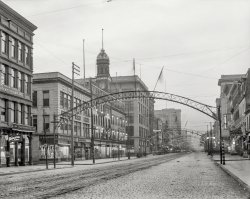
MAY CONTAIN NUTS

Search Shorpy
SHORPY ART

Framed or unframed, desk size to sofa size, printed by us in Arizona and Alabama since 2007. Explore now.
Join and Share
Ad-Free Shorpy
Shorpy is funded by you. Patreon contributors get an ad-free experience.
Learn more.

Recent comments
- Notch shot
- Straight ahead (right, left, left, right)
- Ship lifespans
- New service
- You Say Station, I Say Potato ...
- Iron Age
- Thank you, Cornelius Vanderbilt
- Grand Central Terminal
- If they made a movie of it
- Obsolete by then.
- Half the tonnage at the NYPANO dock
- Ravages escaped, bank notes signed and dated
- Chatham expansion
- Steepled in History
- Made by York
- No Summer Vacation
- Wait a minute ...
- $$$
- Joad on the Road
- Street Lights Survive
- Now & then
- More or Less? It's a lot less
- A new image.
- Same ol' story ...
- $13,589,422,507.55 in 2024 dollar$
- Skinned knuckles
- Not enough
- Completed, and then enlarged
- Awnings
- 500 West Madison Street
Member Photos
The Shorpy
Printporium
Printporium
Search Shorpy
Search results -- 30 results per page
- American Girl: 1922
- ... girl who leaped from stenographer to Queen of Bohemia in a night ... she appears in magazine illustrations, and in the new salon pictures ... Avery Hopwood comedy of turkish bath locale, "Ladies' Night," beginning Sunday evening.
Water Hazard I can hear their ... Posted by Dave - 09/04/2012 - 4:56pm -
![American Girl: 1922 Washington, D.C. "Kay Laurell, 1922." The star of stage and screen, Kay (reclining) was "an American girl who leaped from stenographer to Queen of Bohemia in a night ... she appears in magazine illustrations, and in the new salon pictures -- also on butchers' calendars, soap ads, and so on." Five years after this photo was taken, Kay was dead of pneumonia at age 37. View full size.
In the same boatThey're all beautiful -- back in a time where it was healthy for women to "have a little meat on their bones" (I just think they're healthy looking!) I love the girl who's playing the oar as a guitar -- something I'd do.
Beauts in a boatIs the class clown on the end playing air ukulele? I can only imagine the comments this is going to generate from the male demographic. Yes, the swimsuits are unflattering. And yes, the real knockout is the one sitting behind the Queen of Bohemia.
Proud to call any of 'em "grandma"They are all so lovely and charming and all the age of my father's mother. Sorry about the pneumonia, hope the rest had happy and fulfilling lives. Love the kooky hat, pinned-up suit, and the smoldering look of the second from left. Great picture.
Farrrrr leftShe is the cutest loveliest thing ever seen on Shorpy yet.
To each his own, but --The girl in the boat with the "Queen of Bohemia" is by far the hottest. Wowza!
As a ManI appreciate the low standard established for us. It doesn't take much effort to rise above such a low bar.
Wet and WoollyThey're all adorable, and I'm surprised how sexy those wool swimsuits look. To my surprise, I'm especially captivated by the buxom cutie standing up beside the boat with her hair covered. She looks like she gets all the BS about the queen of Bohemia and is fonder of the water than any of this nonsense.
Most appealing though is the dark haired girl with bangs sitting in the boat. Her face is calm and she seems really for real.
Great photo.
Playing at the Belasco
Washington Post, Jul 6, 1922
Coming to the Theaters
Belasco
The Belasco Players, augmented by such notables as Kay Laurell, the famous Follies beauty, and Eleanor Griffith, late of "The Last Waltz," will next week present the Avery Hopwood comedy of turkish bath locale, "Ladies' Night," beginning Sunday evening.
Water HazardI can hear their mothers saying, "Don't go out in those skimpy suits, you'll catch your death of pneumonia!"
Carole HanelGirl second from right was Carole Hanel, a redhead. Knew her granddaughter.
She's playingoar guitar
Va va voomA boat full of women in bathing suits. What could be better?
Kay in a NutshellTypical show-biz tragedy. Small town girl from Erie, Pennsylvania goes to New York to make it big. While working as a secretary, is discovered in 1914, and became a big hit as a Ziegfeld Girl in the "Follies" shows of 1914 and 1915. Then hits pay dirt -- marrying uber-rich movie producer Winfield Sheehan in 1916. Hits the zenith of her career in the Ziegfeld Follies of 1918, where a very intentional costume malfunction (as the partially exposed French Liberte in a patriotic wartime extravaganza) makes her an international sensation. Heads out west to Hollywood to make movies, like everyone else in the silent era. Gains a reputation of a hard worker, and tries to make the tough transition from chorus girl to "real" actress.
Then it all goes south. Gets divorced from big studio sugar daddy in late 1918 or 1919. Unlike most other former chorus girls, she is unwilling to get ahead by way of the casting couch. Is in a serious car accident in 1919, running off the road at 1:30 a.m. and takes a pretty hard banging around, requiring stitches and hospitalization. Makes only one other movie after that, in 1921. Returns to New York to find stage work. A cast player in one play in 1923 that runs a respectable five months, and then one poor effort in 1925 that flops and closes overnight. Feeling washed up in both theater and film, she retires to London, where she dies of pneumonia in 1927.
I hope she didn't own a dachshund.
On the LeftCan those be shadows on her legs? Looks like socks with cuffs, or stockings, and then from beneath her suit legs to her knees? The world's weirdest sun burn? Or what?
[Those are girdle marks. Just like your ankles might look after taking off tight socks. - Dave]
Before the days of antibioticsHer story reminds us of the many greats in history who had everything but with one cold, TB or pandemic illness were struck down. Today her pneumonia would be easily treated with a shot of antibiotics and some bed rest. In some ways even the poorest of us has the ability to live longer because of cures offered by modern medicine.
mehI love how any photo with women in it gets subjected to choosing which of them is the hottest. I'm sure the the same thing happens with all of the photos of men. Yep.
[Stick around. - Dave]
As a womanI still say the swimsuits are ugly. Now that no one else has asked, I simply must know what the strange round protuberance is near the nether regions of the second lady from the viewer's left. Anyone? A place to put a cork to help her stay afloat?
Available drugsThis young woman's death is almost familiar to me. My grandmother died of pneumonia in the early 1930's, within three days of the onset of illness. My mother always noted, when speaking of her mother's death, that the best drug they had to fight the pneumonia then was quinine. The sulfa drugs didn't become available until the late 1930s.
By the way, I disagree about the cause of the marks on the one girl's legs. I suspect that the rings were left by stockings rolled over an elastic garter.
You Gotta Be Kidding MeWhat happened to slim and trim?
Goose lard and whiskey A few years after Kaye Laurel died of pneumonia, my grandfather contracted double pneumonia. The doctors basically threw up their hands and said there was nothing more they could do. Well, his mother, one of the most bull-headed people who ever lived, showed up at the hospital with a jar of goose lard and a bottle of whiskey. Several times a day, she would go and rub lard on Grandpa's chest and give him a shot of whiskey. This was in about 1932. Grandpa was with us until 1992.
Grandpa said it was divine intervention that saved his life. My great grandmother said it was the goose lard and whiskey. Maybe it was some of both!
Cause of her deathWikipedia states she died in childbirth, which was initially reported as pneumonia since the child was out of wedlock. Wonderful descriptions of her Ziegfield tableaux in that link as well.
(The Gallery, Boats & Bridges, D.C., Natl Photo, Sports)](https://www.shorpy.com/files/images/06828u.thumbnail.jpg)
- Night Riders: 1942
- September 1942. "Boys sleeping as best they can on special train from Richwood, West Virginia, to upper New York state to work in the harvest." 4x5 inch acetate negative by John Collier for the Farm Security Administration. View full size.
... Posted by Dave - 01/02/2023 - 4:23pm -
![Night Riders: 1942 September 1942. "Boys sleeping as best they can on special train from Richwood, West Virginia, to upper New York state to work in the harvest." 4x5 inch acetate negative by John Collier for the Farm Security Administration. View full size.
Unconscious, but conscientious?I was friends with a man who was a conscientious objector in WW2. He was sent to a farm in New York to work the harvest. I wonder if that's what has the lads leaving the almost heaven land of West Virginia.
[Um, no. These are boys not men. - Dave]
PretzellyI bet those teens woke up, stretched once, and got on with their day. If I slept like that now, I wouldn't be able to move for a week!
(The Gallery, Agriculture, John Collier, Kids, Railroads)](https://www.shorpy.com/files/images/SHORPY-8c28012a.thumbnail.jpg)
- Movie Night: 1942
- February 1942. "Tulare County, California. FSA farm workers' camp. At the movies." Not to be outdone by our previous FSA photo , we have two birders here, and three birds! Medium format acetate negative by Russell Lee for the Farm Security Admi ... Posted by Dave - 04/22/2022 - 8:27am -
![Movie Night: 1942 February 1942. "Tulare County, California. FSA farm workers' camp. At the movies." Not to be outdone by our previous FSA photo, we have two birders here, and three birds! Medium format acetate negative by Russell Lee for the Farm Security Administration. View full size.
Re: Third BirdI see a third, about 7 rows from the front, near the left side. And that plaid shirt (behind Double Flipper) has seen better days, for sure!
I ain't touchin' that!Judging by the looks on some of their faces, the film must be the one about STD's.
Two birds, four eyesI see (at least) two people with strabismus in the crowd.
Two "Thumbs" Up!Apparently the young man inn the foreground is doubly displeased with what he's seeing on the big screen.
Long-lived 16mmThat looks very much like the 16mm projector that I used to show movies for my Army company in 1970. (It was a way to avoid guard duty.) They were regular Hollywood films in the 16mm format. This FSA crowd is probably watching something similar.
Portable 16mm sound projectors were popular from the 1930s to the advent of video cassette players. Beyond that, 16mm film was used for the early seasons of 'Sex and the City' and 'Buffy the Vampire Slayer' and for parts of the films 'The Hurt Locker' and Spike Lee's 'Da 5 Bloods' in 2020.
Multiple Avian DisplayThe double bird and the double dog dare were kept in a boy's arsenal only to be deployed when the situation warranted an extreme measure.
GesturesAs a youngster in the 1950s when living overseas, I learned birding the way Flipper and Two-Birds are doing it. When I first got to the States in the very early 1960s is when I learned that American teenagers did it differently. They folded the fingers into the palm of the hand instead of squashing them straight down. Haven't a clue how adults did it since we never associated with them!
Taking a random sample of folks of various ages from teenage to 70+, all seem to have learned and use the folded fingers versus squashed fingers gesture. Wonder when Americans changed from what is shown in the 1940s to what I learned in the early 1960s.
Movin' on up... the Valley: A double-bird ?? Lord, that boy is Folsom Prison bound !!
Kid near the foreground, left of centerEverybody calls him "Red".
Maybe it was a newsreel… and the kid up front is just expressing his opinion of der Fuhrer.
The Third BirdHas no one spotted it?
I think I see the thirdAnd by a girl! She's on the left-center of the photo, with a kind of crazy look in her eyes.
Birds asideWhy are the three kids in the foreground looking at something to our left while all the people behind them are looking off to our right? And why is the kid front and center in the ratty sweater wearing a white glove on one of his hands cupped over his mouth?
[We'll never know! - Dave]
(The Gallery, Agriculture, Kids, Movies, Russell Lee)](https://www.shorpy.com/files/images/SHORPY-8c23889a1.thumbnail.jpg)
- Good Night: 1897
- ... Circa 1897. "Aboard the U.S.S. Brooklyn -- good night." 8x10 inch dry plate glass negative by Edward H. Hart, Detroit ... Posted by Dave - 08/10/2012 - 12:16am -
![Good Night: 1897 Circa 1897. "Aboard the U.S.S. Brooklyn -- good night." 8x10 inch dry plate glass negative by Edward H. Hart, Detroit Publishing Company. View full size.
Posers"Now lie down and pretend you're asleep whilst I take this picture."
Well, this is timely:"The first African American to graduate from the Naval Academy died this week, 63 years after being commissioned into the Navy.
"Retired Lt. Cmdr. Wesley Brown died Tuesday evening.
"He was 85."
...
"At the time Brown was trying to enter the academy, Navy physicians looked for reasons to find the young African American man unfit to attend.
"The only defect they could find was an overbite. After an African-American congressman complained, they gave Brown a second look and deemed him qualified."
Author is one Tina Brown, treed@capgaznews.com so I guess she works for capgaznews (Capital Gazette News? Not at my newsstand.)
There's a little more in the article, which you can probably get with a Google.
According to the Register of Alumni, he stood 372nd in a class of 790 (Class of '49). Bet he had a miserable Plebe Year.
Sleeping with hankDo you suppose the hank of rope everyone appears to have been issued (at least those lucky enough to be issued a hammock) is to lash one's self in when the seas are rough?
Odd compartment!I'm trying to figure out where this would be on this ship.I'm thrown by the ornate wooden doors on the right, the steam heat radiator in the middle and what looks to be a ships wheel on the right! With the wheel there, I'd say aft steering but it can't be.But then again !! Footnote; My ship had an aft steering wheel almost identical the air pump wheel but padded around the rim.Not all ships wheels have handles.
Re: Rope The ropes seen in this photo were most likely used for lashing up the hammocks when not in use. Note the one that is lying on the deck and is being uses as a pillow by the young lad who seems to feigning sleep.
Sleeping in a hammock on a moving ship would not be difficult at all. as the ship rocked the hammock would remain stationary, acting somewhat like a pendulum. the sleepers weight would pull it downward whilst the ship rotated around it. Now, to be honest, rough seas that caused the ship to pitch (rise and fall) rapidly would be a different story.
Interesting to see that this ship has a mixed crew and that the sleeping quarters are not segregated.
IntegrationWe have a mixed race crew who seem to be comfortable in each others company. I thought that the military was segregated until Truman's Presidency.
[Racial segregation in the US Navy began under Woodrow Wilson's administration. -tterrace]
Nevermind the LongjohnsThey've likely set up their hammocks to escape stuffy or overly warm regular quarters. I think the sailors are on an exterior sheltered deck toward the stern, where the auxillary/docking steering would be found. Exterior doors of that louvered type were quite common on ships of that era and don't in and of themselves suggest any interior space (though I doubt you'd find them in an area not well sheltered by a deck above).
Air Pump?For Oldmanmac: The wheel at left isn't the ship's wheel. Too small, and there aren't any handles on the ends of the spokes. I think it's actually part of a hand-operated air pump for supplying fresh air to hard-hat divers. Compare it to this slightly smaller example from the Museum of London.
If you look closely at the Brooklyn's pump, you can see one of the crank handles has been reversed and stuck through the wheel spokes, probably to prevent "owies" in the cramped below decks area.
So much for integrationAnyone notice that the two minority sailors seem to be hammockless? At least there are no empty/rolled hammocks in sight. Re the salt sleeping on the deck, I think the fact that he's not bothered to remove his shoes or deploy his bedding indicates he recently came onboard and is soon due to go on duty.
Lines, not RopesThose spare bits of line are used to trice up the hammocks, as when the order 'All Hands Heave Out and Trice Up' is passed at reveille.
(The Gallery, Boats & Bridges, DPC, E.H. Hart)](https://www.shorpy.com/files/images/SHORPY_4a14125a.thumbnail.jpg)
- Night View: 1932
- New York circa 1932. "Night view, Manhattan." Photo by Berenice Abbott (1898- 1991). Library of ... shortly before Christmas on an extremely clear, cold, dark night some years ago. Preparing for landing we flew low over the city as ... Posted by Dave - 09/04/2013 - 10:33am -
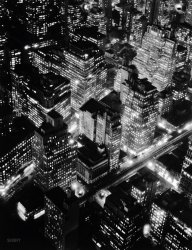
- Water Street, Night: 1943
- ... why blackout regulations weren't seemingly in effect this night while the war raged in 1943. I know the coast was under blackout ... Posted by Dave - 05/09/2017 - 9:21am -
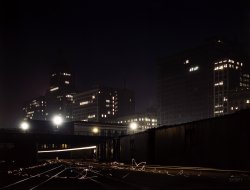
- Night Moves: 1962
- Friday Night Lights circa 1962. A high school football game from the News Photo ... Posted by Dave - 05/06/2022 - 12:43pm -
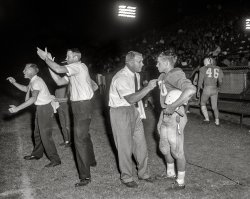
- Night Lights: 1905
- Coney Island circa 1905. "Night in Luna Park." What hath Edison wrought! 8x10 inch glass negative, ...
A modern day Take on Luna Park. Spotted this last night at the New York Botanical Garden Christmas Train Show.
Re: Fishpond ... Posted by Dave - 12/19/2013 - 6:39pm -
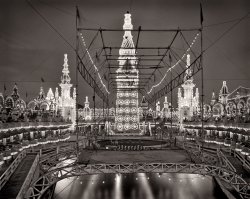
- Silent Night: 1925
- "Volunteers of America, Christmas 1925." A festive table, good friends and that venerable yuletide sentiment "Profanity Positively Forbidden -- Shut Up or Get OUT." Merry Christmas! National Photo Co. glass negative. View full size.
The Sn ... Posted by Dave - 08/13/2012 - 6:09pm -
![Silent Night: 1925 "Volunteers of America, Christmas 1925." A festive table, good friends and that venerable yuletide sentiment "Profanity Positively Forbidden -- Shut Up or Get OUT." Merry Christmas! National Photo Co. glass negative. View full size.
The Snoring TwentiesI'm guessing this was one party Scott and Zelda didn't attend.
Is this supposed to be a party?If this is a party, I think I'll skip it and go count headstones in the cemetary! That will be a lot more exciting than this group of people! Wow. I think Stinky had it right - these people were coerced into "making a party"!!
Something sad about this picture ....... or maybe its just the room they're in. Somebody did their utmost to make things festive but the room is laughing at the decorations. Was the foreground space so limited that they were forced to park the table through the doorway? I'm made to feel "uneasy" looking at this and I cannot say why. Everyone looks "normal", so its something else and I suspect that its just the room itself - but why? I get the impression that they've been forced to make the best of a bad situation here. They wanted to have a group dinner but this was the only space available to them and it "feels" cold and unwelcoming. The ceiling is too high, the paint job is annoying and the floor is scuffed up and dirty looking. Also, besides the sign saying "Shut up Or Get OUT" there's another sign on that rear door saying "Keep Out". The overall effect is off-putting and unfriendly. I'm also sure that none of these attendees would agree with a word I've said. Secondarily, the standing man reminds me of Senator Joe McCarthy and the guy sitting next to him reminds me of Al Gore. All in all, this photo makes me feel sad -- and somewhat pitying that this was the best that they were able to come up with.
Fainting from Hunger?Maybe their glumness is from having to wait to tuck into the turkey and oranges until after the slowpoke photographer gets his dam... er, sorry, dratted picture.
Or maybe it's tied to the state of their shoes. They may be tired after a long day of slogging the streets doing their charity work.
Of course, what I'd really like to believe is that they're plotting the demise of the gentleman at the head of the table, who's guarding all the precious gold in the KEEP OUT room.
All's I really know is, that one coffee cup that's slightly out of alignment at the foot of the table? Somebody is SO getting a firm talking-to from Staff Capt. Myers for that one.
Shining examplesWhy are everyone's shoes in such ridiculously horrible shape in these sorts of photos? I notice it consistently!
It's like no one owns polish.
Take the picture!"There will be no eating until the picture is taken."
Harold, stop closing your eyes! Maude! Close your mouth!"
I think that two people are helping take this picture. There is an open place on the left side of the table as well as the head of the table on our end.
Some of the reasons this looks so unwelcoming:
The tablecloth is meager--does not hide the bare legs of the table.
There is a bare light bulb hanging from the ceiling.
Where are the napkins?!
And while the chairs have a definite "World Market/Pier One" vibe, they are still folding chairs--this is a most temporary set up.
Perhaps a bit heavy-handed?"Shut up or get out"? And good will towards all men and women.... Also, I hope there was more than one bird to feed 14 men, two women and a child.
Volunteer RecognitionVolunteer organizations all over the USA still look for venues large enough to honor the entire staff of volunteers at one time. Likely this hall was called into use for this occasion, hence the squeezing in.
This being 1925 this hall was likely used to gather those down-on-the-luck, perhaps a day labor room, or a forerunner AA meeting. Those are pocket doors. Staff Captain Myers might have been the Salvation Army guy in command and we know how the Army feels about profanity, boy howdy we sure do.
How long did they have to sit motionless for the camera to focus? I remember this same paralyzed looks on the faces of my family when dad brought home the first DONT MOVE Polaroid.
And what about that baby front and center--what’s that tyke doing there? I am captivated by those big cups--that for chowder? This photo begs to be studied with a magnifier--see what we can see.
No grinning either!The fourth fellow on the left, you can see his teeth. He can get out too!
And not a napkin in sight.What were they thinking?
In reply to Shining ExamplesI'm just guessing here, but maybe it has something to do with the age of the shoes. Today we think nothing of going to the mall and buying a new pair when they get slightly scuffed, but, I believe, as with everything else, there was a "Use it up, wear it out, fix it up, or make do" feeling back then that we seem to have lost today. I don't imagine they ran out to get new shoes for all occasions, plus they were sturdier (the shoes, and the people), and built to last.
(Shoe, last, get it? I'm so bad.)
In 1925 . . . .No one ever polished their shoes.
No one ever mopped the floor.
Spot cleaning of uniforms was forbidden.
No one could smile while having their picture taken.
There were TWO turkeys on the table to feed all those people.
And it goes "Use it up, wear it out, make it do or do without."
I feel so much better now.
Re: Shining ExampleAlso remember, that in 1925 if your soles wore out, you had new ones put on (if you could afford it) and kept wearing them. Who knows how old those shows actually are. It's funny, I'm young enough to grow up in the disposable/k-mart thinking, but still have enough "Use it up, wear it out, make it do or do without" in me to not throw out a pair of shows that still have a sole on them.
[Like they say, the show must go on. - Dave]
(The Gallery, Christmas, D.C., Natl Photo)](https://www.shorpy.com/files/images/32244u.thumbnail.jpg)
- Night Rider: 1921
- Circa 1921. "Oakland window." A showroom display at District Oakland Co., 1709 L Street N.W. in Washington, for the General Motors brand that in 1926 would beget Pontiac. National Photo Co. Collection glass negative. View full size.
Locati ... Posted by Dave - 09/04/2012 - 4:54pm -
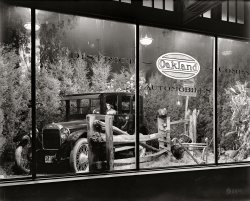
- Election Night: 1909
- November 2, 1909. Watching the municipal election returns at the offices of the New York Herald and Evening Telegram, with the results beamed out from the projection booth using slides. William Gaynor was elected mayor. 8x10 glass negative, George ... Posted by Dave - 09/09/2011 - 7:45pm -
![Election Night: 1909 November 2, 1909. Watching the municipal election returns at the offices of the New York Herald and Evening Telegram, with the results beamed out from the projection booth using slides. William Gaynor was elected mayor. 8x10 glass negative, George Grantham Bain Collection. View full size. Lots to see here.
Not a woman in the crowdNot a woman in the crowd that I can spot (perhaps since they didn't have the vote), yet over the scene hangs the prominent ad for corsetry. Ha!
Sen-SenI see one woman. I also see a billboard for Sen-Sen, one of my favorite atavistic brands (the other being Moxie). Sen-sen is remembered today chiefly because it is mentioned in the lyrics to the song "Ya Got Trouble" in "The Music Man."
They're tryin' out Bevo, tryin' out cubebs,
Tryin' out tailor-mades like cigarette fiends!
And braggin' all about
How they're gonna cover up a tell-tale breath with Sen-Sen.
I use the term "atavistic" brand, rather than "obsolete" because Sen-Sen can still be purchased in a few venues (and, of course, online).
CHA
[And let's not forget Zoolak. "Unequaled for the stomach." - Dave]
I won?!Is this where the election term "projecting the winner" comes from?
Times have changedI managed to find two woman (large hat, near the small tree at the back of the streetcar at the left of the photo; and in front of the projection booth) and two black men, both in front of the projection booth. Look where we are a hundred years later.
Sen-SenHad some difficulty finding the Sen-Sen billboard, I finally managed to do so, the ad appears to be for Sen-Sen Gum: "Little Girls like it"
Found on a page at the interesting site called "Friends of Historic Third Lake Ridge".
(The Gallery, G.G. Bain, NYC)](https://www.shorpy.com/files/images/02556u.thumbnail.jpg)
- Night and the City: 1917
- ... waiting to see if they would be allowed in for the night
(The Gallery, G.G. Bain, NYC) ... Posted by Dave - 09/09/2011 - 7:49pm -
![Night and the City: 1917 January 18, 1917. "New York Municipal Lodging House. Waiting for the doors to open." View full size. 8x10 glass negative, George Grantham Bain Collection.
Hatsit's a real sign of the times that no matter how down on your luck you were, you always wore a hat.
NYMLH1991 New York Times article on the Municipal Lodging House.
Excerpt:
IF Mayor David N. Dinkins has been perturbed by the opposition to his plan for 100-bed shelters for the homeless, he would surely take a suggestion for a facility 10 times that size as a bad joke.
Yet that is exactly what New York City put up in 1909 at 432 East 25th Street. This shelter stood for 40 years but the chilling irony is that the 1909 Municipal Lodging House remains the only city building built in Manhattan for single homeless men and women.
Homeless ShelterThat's a lot of tenants who did not have the freedom to get into their own bed until someone else said they could!
I'd love to learn more about this one too.
[So far we have six photos of the New York Municipal Lodging House, with more information in the comments. - Dave]
ShelterThe hangdog expression on the policeman's face speaks volumes. What was the story on the New York Municipal Lodging House? Sure seems like a popular place.
Covered FacesIt's also very interesting to note that a number of men have purposefully covered their faces or lowered their heads, as if to not be identified. It's also interesting to note the group of men standing off to the right toward the back of the picture. Why have they remained separate? Just interesting.
LiteraryReminds me of Down and Out in Paris and London. Many scenes just like these with all the "tramps" waiting to see if they would be allowed in for the night
(The Gallery, G.G. Bain, NYC)](https://www.shorpy.com/files/images/01803u1_0.thumbnail.jpg)
- East River Rapids: 1904
- ... depicted Brodie's supposed feat, closed after opening night, a legendary belly flop.
The Great Bridge David McCullough's book ... Posted by Dave - 06/05/2024 - 11:48am -

- Night on Catherine: 1954
- "Montreal July 1954. Night on Catherine and Peel Streets." From Set 3 of found 35mm Kodachrome ... Posted by Dave - 03/09/2008 - 3:07pm -
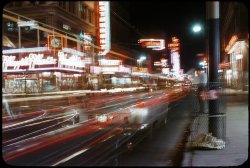
- North by Night: 1940
- ... in with the faint whisper of the evening breeze and summer night insect sounds, I hear the gentle double-slam of those ornate screen ... Posted by Dave - 05/02/2021 - 3:03pm -
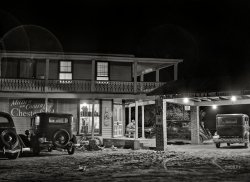
- Night Ride: 1943
- ... "Baltimore, Maryland. Trolley leaving the terminal at night." Photo by Marjory Collins for the Office of War Information. View full ... Posted by Dave - 11/26/2013 - 2:28pm -
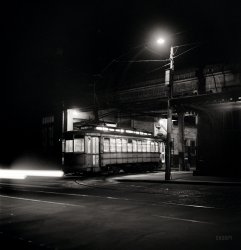
- Good Night, Mrs. Calabash: 1952
- 1952. Jimmy Durante rehearsing for the "Colgate Comedy Hour" or "All-Star Revue." Photos by Maurice Terrell and Earl Theisen for a Look magazine article about the TV producer Sam Fuller, "He Keeps Them Happy." View full size.
Ham it up ... Posted by Dave - 06/06/2013 - 12:44am -
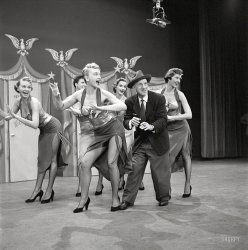
- Fight Night: 1897
- Aboard the U.S.S. Oregon circa 1897. "Waiting for the gong." 8x10 inch dry plate glass negative by Edward H. Hart, Detroit Publishing Company. View full size.
Refreshment I see the guy on the right has beer bottle for his 'water'. T ... Posted by Dave - 08/10/2012 - 12:35am -
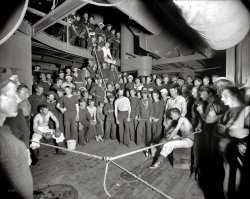
- Night Train: 1943
- ... A view of the Atchison, Topeka & Santa Fe yard at night." Medium-format negative by Jack Delano. View full size.
2-10-2 ... Posted by Dave - 01/07/2013 - 3:46pm -
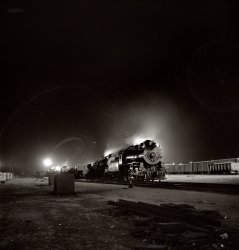
- Night Ride Home: 1969
- February 1969. "Night Traffic." This Kodachrome of Oceanside from a San Diego Freeway overpass ... Posted by Dave - 07/25/2021 - 8:00pm -

- Texas Saturday Night: 1942
- February 1942. Weslaco, Texas. Saturday night dance at the Farm Security Administration camp with music by the Drake ... Posted by Dave - 07/10/2009 - 12:38am -
![Texas Saturday Night: 1942 February 1942. Weslaco, Texas. Saturday night dance at the Farm Security Administration camp with music by the Drake family. View full size. Medium-format safety negative by Arthur Rothstein for the FSA.
FriskySeems like the young man dancing with the polka dot girl is getting a bit "handsy."
[That's two girls dancing. - Dave]
Wish I had a time machineOh, how I'd love to go to that dance!
Facial ExpressionI wonder what the woman in the center is thinking? She appears to have on a wedding ring, but they are dancing like they aren't too close. She doesn't look unhappy, but she is clearly thinking about something!
[Maybe the next call in the square dance. - Dave]
(The Gallery, Arthur Rothstein, Drake Family, Music)](https://www.shorpy.com/files/images/8b37738u1_0.thumbnail.jpg)
- Edge of Night: 1958
- ... to the outer sheet metal, which then condensed in the cold night air and formed frost. But the top is definitely a layer of frosty snow. ... Posted by Dave - 08/22/2015 - 4:12pm -
![Edge of Night: 1958 Castro Valley, Calif., circa 1958. "Accident, Seven Hills Road." One sunburned '55 Ford Fairlane, saved. 4x5 acetate negative from the News Archive. View full size.
Whew!Besides a fresh coat of paint, I'm guessing the Ford could use a thorough cleaning of the driver's seat cushion after this near-miss.
License platesThe license plate frame outlines the shape of California tags prior to 1956. In 1956 all states standardized the size and shape of their license plates. That standard is still in use today.
SnowThat looks like snow, not faded paint. There are a couple patches on the hood too, where the engine heat could more easily get through to the outer sheet metal, which then condensed in the cold night air and formed frost. But the top is definitely a layer of frosty snow.
[Look up the average low and record low temps for Castro Valley. - Dave]
Yes, well into the 20s and 30s for record lows, and if they came down from mountains, they had plenty of chances to be snowed on. The lighting of the roof snow clearly shows highlights and shadows that indicates a layer of snow, not faded paint. But I was incorrect about the reason for the patches of snow on the hood. I forgot that there are areas where insulation is attached to the underside between the formed crossbeams. So those areas stay cooler and don't melt.
That's a powerful flashThe flash is illuminating the back of the truck, which is awfully far away. Were there such things as extra-jumbo flash bulbs?
Also the dapper tow-truck tech appears to have very highly reflective shoes.
Flash bulbs were powerful.Press photographers in the 50s typically used GE #5 or Sylvania Press 25 flashbulbs. These had a guide number of about 240 for 100 ASA film - that's 42 feet at f/5.6.
(The Gallery, Cars, Trucks, Buses, News Photo Archive, Signal 30)](https://www.shorpy.com/files/images/SHORPY-565.thumbnail.jpg)
- Night Shift: 1909
- November 1909. Two of the boys on night shift in the More-Jones Glass Co., Bridgeton, New Jersey. View full ... Posted by Dave - 08/15/2012 - 9:23am -
![Night Shift: 1909 November 1909. Two of the boys on night shift in the More-Jones Glass Co., Bridgeton, New Jersey. View full size. Photograph by Lewis Wickes Hine.
JauntyI love how their hats are pushed off to the side. They look like they're having a playful moment here.
Kid on the leftMan, that is a good-looking kid. A century later he'd be River Phoenix. Instead he got to be a child laborer.
[Considering what happened to River Phoenix, maybe our boy got the better deal. - Dave]
OH MYNow THAT kid is CUUUUTE!!! And look at his MUSCLES!
Hey I'm 16 year old girl......what can I say?
(The Gallery, Kids, Lewis Hine)](https://www.shorpy.com/files/images/05440u.thumbnail.jpg)
- Turkey Night: 1956
- A December 1956 holiday kitchen scene in a found Kodachrome slide from Alhambra, California. View full size.
Wings Do I see a saint? Or at least an angel. Also, over on the windowsill, a Virgin.
Mary Christmas There's another Vir ... Posted by Vintagetvs - 12/31/2017 - 7:56pm -
![Turkey Night: 1956 A December 1956 holiday kitchen scene in a found Kodachrome slide from Alhambra, California. View full size.
WingsDo I see a saint? Or at least an angel. Also, over on the windowsill, a Virgin.
Mary ChristmasThere's another Virgin on what looks like a church calendar with the Blessed Mother as December's picture.
Those curtains have been starched within an inch of their lives! I admire the way they were pressed. They look like they would break if they were touched, and that's not meant as an insult. Mother's apron and dress have been pressed well, too, but with much less starch.
Is that a coffeepot in the dish drainer? It's shiny enough to give a good reflection, but my vision isn't sharp enough to tell what it reflects.
It's Edgar!That seems more like a crow effigy she's holding up.
And, the glasses are as classic as the turquiose tile - Lucky it wasn't avocado or copper like my mom's kitchen!
And I imagine Mom doesn't trust Dad to carve the turkey, so it happens in the kitchen.
MysteryWhy is it so dark outside?
[Late, probably cloudy afternoon sun plus exposure stopped down for bright, close-quarters flash. - tterrace]
Blue tileI live in a home that was built in 1955. In one of the bathrooms we have that same blue tile. My Wife hates it !
Past my bedtime9:30!
And here I thought we ate late.
[According to the clock, more like 3:55.]
Let The Skin Wars Begin!Those ladies knew how to roast a turkey to crispy skin perfection.
My sister and I didn't give a hoot about white meat or dark meat all we wanted was that crispy skin so for the sit down part of a holiday meal we usually settled for a wing but we kept a wary eye on each other when the turkey was taken into the kitchen.
Any unguarded turkey with that crisp Old Bay flavored skin was fair game for us. It belonged to us and no one else in the family and once enough time had passed we excused ourselves and made a dash to the kitchen to gobble down that gobbler's skin.
(ShorpyBlog, Member Gallery, Christmas)](https://www.shorpy.com/files/images/Alhambra-Xmas-1956.thumbnail.jpg)
- Saturday Night: 1942
- January 1942. Community house Saturday night dance in the Farm Security Administration settlement of Woodville, ... Posted by Dave - 09/05/2012 - 4:10pm -
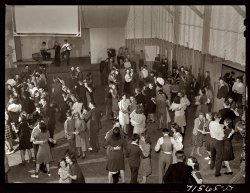
- Night Swimming: 1952
- "North Columbus Recreation Dept. 1952." What seems to be a ceremony involving ribbons and cake. 4x5 negative from the News Photo Archive. View full size.
Swim Meet After Party Yup, I remember these. They were called 'swim meets', and th ... Posted by Dave - 08/26/2015 - 10:52pm -
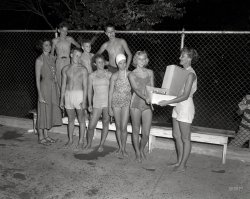
- The Night Shift: 1909
- November 19, 1909. "A group working on night shift at Hereford Glass Works, Cape May Court House, New Jersey. I saw ... Posted by Dave - 12/14/2012 - 12:05pm -
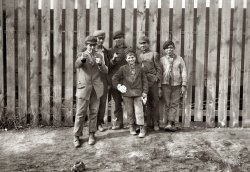
- Bromo Tower: 1912
- ... car one morning on a train, obviously hung over from a night in the bar car. The steward asked if he could get Mr. Fields a Bromo, to ... Posted by Dave - 04/27/2024 - 12:20am -
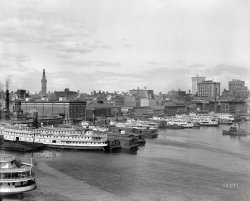
- Death Star: 1902
- ... are an awful lot of open windows.
It Hyphened One Night The Waldorf-Astoria was originally built as 2 separate hotels by ... Posted by Dave - 06/25/2023 - 12:40pm -
![Death Star: 1902 Circa 1902. "The Waldorf-Astoria, New York." The original, and somewhat forbidding, Waldorf at Fifth Avenue and 34th Street. Complete with the obligatory windowsill milk bottle. 8x10 inch dry plate glass negative, Detroit Photographic Company. View full size.
OK - I give up.What's an "obligatory windowsill milk bottle?"
[A familiar sight on these pages. Left out to chill. - Dave]
It stood for less than 40 yearsTorn down in 1929 to make way for the Empire State Building.
The storks also deliver milk!It's amazing that, in addition to tiny babes, the storks are also adept at delivering windowsill milk bottles.... 7 stories high!
34th StreetThe street on the north side, the one with the trolley, appears narrower than it is today. It may be an optical illusion but it seems to be missing a lane on both sides. Today 34th Street is one of the busiest in the city, leading east to the Queens-Midtown Tunnel and Long Island and west to the world's largest store, Macy's, and continuing to the Lincoln Tunnel to New Jersey and points beyond. This of course, takes nothing away from the magnificent old Waldorf or its successor, the landmarked Empire State Building.
Police HatAlways a little tip-off on the season to check the hats of the cops. The gray ones were worn in summer, blue in Winter. Likewise with the straw hats. There was a season for them, much like we used to say about white pants. There was the famous "straw hat riot" in 1922 where a bunch of street toughs started ripping the skimmers off men who'd worn them after the agreed-upon cut-off date.
[Probably the best seasonal tipoff: Windowsill milk bottles! - Dave]
v = ?(2gx)Given the generous "no walk" zones at sidewalk level, do you
suppose the engineers took the milk bottle "Oops Factor" into
consideration?
Movie SetLooks like Sigourney Weaver's apartment building in "Ghostbusters."
[Which was on Central Park West. - Dave]
It may be cold outside but it's sure hot in here!I guess the steam heat was cranking because there are an awful lot of open windows.
It Hyphened One NightThe Waldorf-Astoria was originally built as 2 separate hotels by feuding members of the Astor family. The Waldorf on the left (the shorter half) was built in 1983 1883, and the Astoria on the right was completed in 1897. The two were soon operated as one hotel, but it's apparently possible to separate them back into two distinct entities if needed.
One assumes that ..you could get a Waldorf Salad here. And screwdrivers.
The Waldorf SaladIt seems like Doghouse Riley has been watching too many Fawlty Tower reruns, as well as myself. The Waldorf Salad episode is one of my favorites.
Astor CourtThe banner on top of the short building on the right probably reads "Astor Court" - not "Astoria." The Astor Court Building stood just west of the private alley (also called Astor Court) that separated it from the Waldorf-Astoria Hotel. All of this became part of the site of the Empire State Building.
Tricks of the House WreckersModern Mechanics featured the demolition of the Waldorf Astoria in the June 1930 issue. Click to enlarge.
Penthouse ViewsWhat would the uses of the top several floors be in this building? They are very unusual; the arrangement, size and shape of the top floor windows.
Actuallythe name was the Waldorf=Astoria! The "=" sign was put in because the cousins who built the two side by side hotel couldn't agree on whose name would be first in the new name!
I would have loved to have stayed here, even in the smallest room.
The old family homesteadAccording to an old family legend, an ancestor of mine once had his farm at this location in the early 19th century. I'm sure he'd kick himself If he could see what the property values were now!
What a beauty!I'd like to live there those times and see it with my own eyes!
Maitre d' MarcosMy grandfather Marcel Burgos was maitre d' for this Waldorf for many years during the 1920s. My dad told many stories about him. Anybody out there have any records of any employes from there?
(The Gallery, DPC, NYC, Streetcars)](https://www.shorpy.com/files/images/4a09397a.thumbnail.jpg)
- Columbus Night: 1908
- Circa 1908. "High Street at night, Arch City, Columbus, Ohio." If you can't get into Bliss College, there's ... Posted by Dave - 10/17/2016 - 12:31pm -
